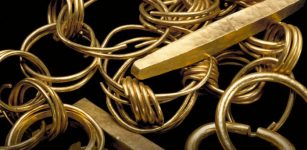Hephaestus (Hephaistos) – God Of Fire And Master Craftsman Constructed Talos, First Greek Robot And Divine Weapons Of The Gods
A. Sutherland - AncientPages.com - In Greek mythology, Hephaestus was the god of fire, divine blacksmith, inventor, and patron of crafts. He was often depicted with blacksmiths' attributes such as a sword, a hammer, or pincers. The cult of Hephaestus was based in Lemnos, a Greek island in the northern part of the Aegean Sea.
Hephaestus was the god of fire, divine blacksmith, inventor, and patron of crafts. Credit: Adobe Stock - Alejandro
In Roman mythology, he is Vulcan, and he also has his counterparts in Svarog, the Slavic god of celestial fire and patron of blacksmiths. He can also be compared to Wayland the Smith, widely known in Scandinavian, German, and Anglo-Saxon legends. As Hephaestus also Wayland was hurt badly, so he could not walk.
His supernatural skills and deep devotion to blacksmithing helped him make weapons, which "no blow could break," many ornaments of gold and silver, and other magical items.
Hephaestos Was Lame And Had A Sad Childhood
Hephaestos' life from the beginning was hard. No one was interested in celebrating the birth of Hephaestus, even his mother, Hera, who was a pre-Greek deity, the earth goddess of Argos, the sister-wife of Zeus. It is unclear whether Hephaestus was born lame or whether he was lamed.
Hera had awaited Hephaestus - child impatiently, hoping to see a beautiful and gifted child that would make her husband Zeus forget all his consorts and children he had with them. It should be mentioned that various ancient authors were uncertain whether Zeus was the father of Hephaestus. Many ancient literary sources say that Hera gave birth to Hephaestus on her own.
Though the identity of Hephaestus' parents is still a topic of discussion, most myths reveal this mighty blacksmith was credited with several incredible inventions.
According to one version of the story, when the baby was born, Hera was shocked because the child was ugly. She knew that such an ugly child would be more trouble for her than happiness, so she threw him from the residence of the gods, Mount Olympus, to Earth. The boy survived this fall because he was immortal and was found by Eurynome, one of the three thousand daughters of Okeanos and the Nereid Thetis.
Thetis Receiving the Weapons of Achilles from Hephaestus by Anthony van Dyck (1630-1632). Credit: Public Domain
The goddesses nursed the young god, but unfortunately, the terrible fall had injured his legs and left him lame for the rest of his life. Raised by Eurynome and Thetis in secret, Hephaestus lived for nine years hidden away beneath the waters and spent his time perfecting his tools and creating formidable objects for the sea-nymphs, the only friends he had. He loved his work and blacksmithing, which were his great passion from a very young age, but he was also a vulnerable, angry young man with personal feelings. He knew Olympus rejected him.
Indeed, no one was waiting for him there, but he decided to return to rejoin his mother and take his rightful place among the Olympian gods.
Palace And Workshop Of Hephaestus
One day, his mother Hera saw the goddess Thetis wearing a beautiful necklace, and she learned Hephaestus had made it. She brought her earlier rejected son to Mount Olympus and arranged a palace and a workshop for him.
"His palace was said to have shone as brilliantly as the stars. Inside the palace was his workshop, where he made exquisite items for both humans and his fellow gods…" (Walsh Nicos, Greek Mythology).
Talos was an advanced ancient Greek robot - Credit: Adobe Stock: kuco
Hephaestus was still not treated equally, and his brothers and sisters looked down on him because he was a disabled god. It took a long time before Hephaestus was finally recognized for his incredible talent and honored in the family.
In later versions of Hephaestus' myth, his workspace was located within Mount Aetna in Sicily. Many believed that when the volcanoes of Sicily and Lemnos showed signs of activity, Hephaestus was busy with forging. It is also why Hephaestus was also considered the god of volcanoes.
Some myths say that the Cyclopes, great forgers themselves, worked as Hephaestus' assistants in his volcanic workshops.
Our earlier article wrote that "Talos" was the first ancient Greek robot. This fully operational machine was constructed by Hephaestus, who invented various automated devices, delicate jewelry, household machines, and developed techniques comparable to our modern technological achievements.
Among his many achievements were, for example, Zeus' thunderbolts, Eros's arrows, Achilles' shield described in Homer's "Iliad" and a "magical" helmet, so-called Hades' cap of invisibility, and he even fashioned the first woman from clay.
Updated on January 13, 2022
Written by – A. Sutherland AncientPages.com Senior Staff Writer
Copyright © AncientPages.com All rights reserved. This material may not be published, broadcast, rewritten, or redistributed in whole or part without the express written permission of AncientPages.com
Expand for referencesCotterell, Arthur. A Dictionary of World Mythology
Sears K. From Gods and Goddesses to Monsters And Mortals
Hamilton, E. Mythology: Timeless Tales of Gods and Heroes
More From Ancient Pages
-
 Rare Medieval Chess Piece And Game Collection Unearthed At A Forgotten Castle
Archaeology | Jun 7, 2024
Rare Medieval Chess Piece And Game Collection Unearthed At A Forgotten Castle
Archaeology | Jun 7, 2024 -
 Who Were The Blue People Of Kentucky?
Featured Stories | Apr 5, 2022
Who Were The Blue People Of Kentucky?
Featured Stories | Apr 5, 2022 -
 World’s Oldest Known ‘True’ Saddle Discovered In East Asia
Archaeology | Dec 11, 2023
World’s Oldest Known ‘True’ Saddle Discovered In East Asia
Archaeology | Dec 11, 2023 -
 Extraordinary Bronze Age Jewelry Hoard Discovered In A Carrot Field In Switzerland
Archaeology | Oct 18, 2023
Extraordinary Bronze Age Jewelry Hoard Discovered In A Carrot Field In Switzerland
Archaeology | Oct 18, 2023 -
 Unique Viking Age Runestone With A Cross And Animal Biting Its Own Tail Discovered By Farmer In Sweden
Archaeology | Sep 20, 2020
Unique Viking Age Runestone With A Cross And Animal Biting Its Own Tail Discovered By Farmer In Sweden
Archaeology | Sep 20, 2020 -
 Mystery Of Doppelgangers And Spirit Doubles – From Ancient To Modern Times
Featured Stories | Sep 16, 2014
Mystery Of Doppelgangers And Spirit Doubles – From Ancient To Modern Times
Featured Stories | Sep 16, 2014 -
 Archaeologists Have Discovered A Mummy Wrapped In Gold – Here’s What It Tells Us About Ancient Egyptian Beliefs
Featured Stories | Feb 7, 2023
Archaeologists Have Discovered A Mummy Wrapped In Gold – Here’s What It Tells Us About Ancient Egyptian Beliefs
Featured Stories | Feb 7, 2023 -
 Pazyryk Carpet: Extraordinary Craftsmanship Of Siberian Iron Age Textile Dyers
Archaeology | Mar 5, 2021
Pazyryk Carpet: Extraordinary Craftsmanship Of Siberian Iron Age Textile Dyers
Archaeology | Mar 5, 2021 -
 Were The Knights Templar Guilty Or Innocent Of The Crimes Laid Against Them?
Featured Stories | Dec 24, 2020
Were The Knights Templar Guilty Or Innocent Of The Crimes Laid Against Them?
Featured Stories | Dec 24, 2020 -
 Baba Yaga Lego Created By Russian Artist Brings Classic Slavic Mythological Figures To Life
Myths & Legends | Feb 23, 2021
Baba Yaga Lego Created By Russian Artist Brings Classic Slavic Mythological Figures To Life
Myths & Legends | Feb 23, 2021 -
 Grave Of Amazon Warrior Who Lived In The Kingdom Of Urartu Discovered In Armenia
Archaeology | Nov 28, 2019
Grave Of Amazon Warrior Who Lived In The Kingdom Of Urartu Discovered In Armenia
Archaeology | Nov 28, 2019 -
 What Was It Like To Be A Student In The Middle Ages?
Ancient History Facts | Jun 6, 2019
What Was It Like To Be A Student In The Middle Ages?
Ancient History Facts | Jun 6, 2019 -
 Anansi The Spider: Trickster And Spirit Of Knowledge In African Mythology
African Mythology | Jul 20, 2016
Anansi The Spider: Trickster And Spirit Of Knowledge In African Mythology
African Mythology | Jul 20, 2016 -
 Lost Ancient Dragon City Of The Xiongnu Empire Discovered In Mongolia
Archaeology | Jul 22, 2020
Lost Ancient Dragon City Of The Xiongnu Empire Discovered In Mongolia
Archaeology | Jul 22, 2020 -
 Forgotten Ancient Empire That Extended Far Beyond America To Iceland And Its Mysterious Inscriptions
Featured Stories | May 6, 2021
Forgotten Ancient Empire That Extended Far Beyond America To Iceland And Its Mysterious Inscriptions
Featured Stories | May 6, 2021 -
 Why Is The Yarm Viking Helmet Special?
Archaeology | Aug 10, 2020
Why Is The Yarm Viking Helmet Special?
Archaeology | Aug 10, 2020 -
 On This Day In History: Julius Caesar Assassinated – On Mar 15, 44 BC
News | Mar 15, 2017
On This Day In History: Julius Caesar Assassinated – On Mar 15, 44 BC
News | Mar 15, 2017 -
 Early Humans Reached Northwest Europe 45,000 Years Ago – New Research Shows
Human Beginnings | Jan 31, 2024
Early Humans Reached Northwest Europe 45,000 Years Ago – New Research Shows
Human Beginnings | Jan 31, 2024 -
 Timboholm Great Golden Treasure Dated To Iron Age’s Great Migration Period
Artifacts | Oct 19, 2018
Timboholm Great Golden Treasure Dated To Iron Age’s Great Migration Period
Artifacts | Oct 19, 2018 -
 Natural Wonders: ‘Fingal’s Cave’ – An Enigmatic Place Shrouded In Mystery And Legend
Featured Stories | Mar 18, 2023
Natural Wonders: ‘Fingal’s Cave’ – An Enigmatic Place Shrouded In Mystery And Legend
Featured Stories | Mar 18, 2023



